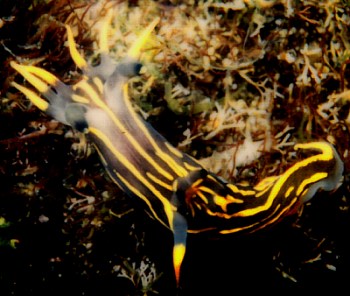
Polycera aurantiomarginata
García Gómez & Bobo, 1984
Order: NUDIBRANCHIA
Suborder: DORIDINA
Family: Polyceridae
Subfamily: Polycerinae
DISTRIBUTION
West Africa [Angola, Senegal] to Spain. Mediterranean records from southern Spain & Tunisia.
PHOTO
Bay of Algeciras (Strait of Gibraltar, Southern Spain) at 23 depth. Size: 20 mm. September, 2000. Photo: Alma Sanchez.
The animal is dark grey or black, somewhat more translucent around the anterior end. There are characteristic yellow marks as shown on the photo. The translucent black gills, not clearly seen in this photo, have a yellow line up both the inner and outer edge of the rachis.
There is a dark blue form of Polycera quadrilineata which closely resembles the blue adult form of Polycera aurantiomarginata. P. aurantiomarginata always has an orange border to the foot as its name suggests. The two species can also be distinguished in the colour of the rhinophore club - in P. aurantiomarginata at least the upper half, but not the tip is bluish-black, and in P. quadrilineata, yellow or orange. Similarly the apical part of the gills are black in P. aurantiomarginata and yellow in P. quadrilineata. Another difference is in the number of cephalic processes on the anterior mantle edge - - in P. aurantiomarginata there are 6-7 and in P. quadrilineata usually 4.
Polycera xicoi Ortea & Rolan, 1989 from Cape Verde Ids is a synonym.
Polycera chilluna from the western Atlantic is almost certainly a senior synonym.
Reference:
• Garcia-Gomez, J.C. & Bobo, A (1984) Una nueva especie de Polycera Cuvier (Mollusca: Nudibranchia) del litoral iberico. Cah. Biol. Mar., 25: 361-373.
• Ortea, J. & Rolan, E. (1989) Descripcion de una nueva especie del genero Polycera Cuvier, 1816 (Mollusca, Nudibranchia) del Archipielago de Cabo Verde. Publicaçoes Ocasionais da Sociedade Portuguesa de Malacologia, 14: 23-28.
• Valles, Y., Valdes, A. & Ortea, J. (2000) On the phanerobranch dorids of Angola (Mollusca, Nudibranchia): a crossroads of temperate and tropical species. Zoosystema, 22(1): 15-31.
Rudman, W.B., 2001 (February 19) Polycera aurantiomarginata García Gómez & Bobo, 1984. [In] Sea Slug Forum. Australian Museum, Sydney. Available from http://www.seaslugforum.net/find/polyaura
Related messages
Re: Polycera aurantiomarginata - mating & eggs
February 25, 2008
From: David Abecasis
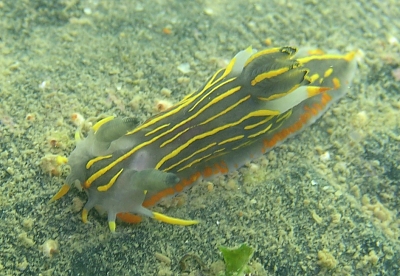
Concerning message #9475:
Hello Bill,
I've found several specimens of Polycera aurantiomarginata on top of a artificial structure in a coastal lagoon. There were about 15 specimens and some of them were mating. This species is frequently seen inside Ria Formosa.
Locality: Ria Formosa, 2 metres, Faro, Portugal, Atlantic Ocean (coastal lagoon), 17 January 2008, sand bottom. Length: ~15mm. Photographer: David Abecasis.
Regards,
David Abecasis
davidbecas@netcabo.pt
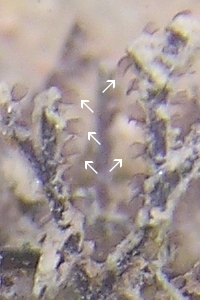
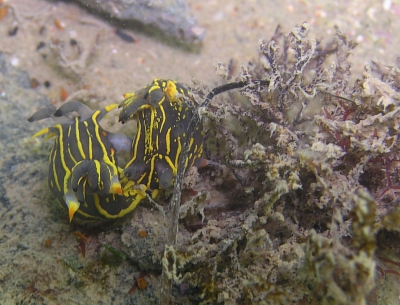
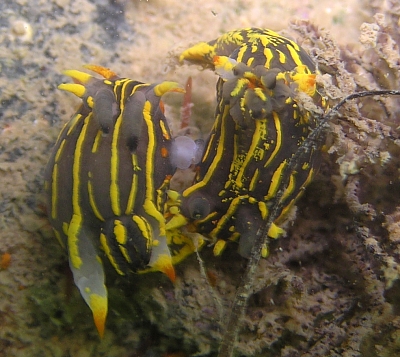
Thanks David,
I've included a close-up of one of your photos to show the cup-like circlet of feeding tentacles [arrows] along the branches of the bryozoan which I presume the Polycera is feeding on. In your photo, the bryozoan colony could easily be mistaken for a clump of reddish algae unless you look very carefully.
Best wishes,
Bill Rudman
Re: Polycera aurantiomarginata from Tunisia
April 28, 2003
From: Juan Lucas Cervera
Hi Bill,
Concerning your question about the limits of the Western Mediterranean, this a not an easy matter. This may depend of the animal group, but in general the area of the Strait of Gibraltar seems to have a higher Atlantic composition or influence, although you can find also Mediterranean species. There are few groups in which this subject has been studied (it seems to me Sponges, Bryozoans and Tunicates). For opisthobranchs, I hope to include a chapter with this matter in a paper that I'm preparing together other Spanish and Portuguese colleagues. At the moment, I'd rather wait until our analysis is omplete before saying anything.
Nevertheless, the coasts from Granada to Almeria can be considered mainly to have a Mediterranean influence.
Regards.
Lucas.
lucas.cervera@uca.es
Cervera, J.L., 2003 (Apr 28) Re: Polycera aurantiomarginata from Tunisia. [Message in] Sea Slug Forum. Australian Museum, Sydney. Available from http://www.seaslugforum.net/find/9772Thanks Lucas.
Bill Rudman
Re: Polycera aurantiomarginata from Tunisia
April 22, 2003
From: Juan Lucas Cervera.
Dear Anis and Bill,
Definitely, this species this species is Polycera aurantiomarginata. There are two early Mediterranean recors of this species but always from southern Spain:
• Templado, J., Luque, A. & Moreno, D. 1988.- Nuevas aportaciones al conocimiento de los opistobranquios del sureste español. Iberus, 8(1): 15-23.
• Sanhez Tocino, L., Ocana, A. & Garcia, J.F. 2000. - Contribución al conocimiento de los moluscos opistobranquios de la costa de Granada (sureste de la Península Ibérica). Iberus, 18(1): 1-14.
This species is also included in the Ocaña et al's book Guia de Invertebrados No Artropodos (2000), but is the same specimen as recorded by Sanchez-Tocino et al (2000).
On the other hand, let me correct a mistake about the distribution of this species introduced by me in an earlier message. I misunderstood the distribution supplied by Valles et al (2000), interpreting that P. aurantiomarginata was found also in Namibia. This is wrong. One of the localities in this paper was Praia Amelia (Namibe Province) from Angola, NOT Namibia. So, the southermost record of this species is from Angola.
I'm sorry.
Regards.
Lucas.
lucas.cervera@uca.es
Thanks Lucas,
I wasn't sure whether to consider the southern Spain records as 'in' the Mediterranean or 'in the doorway'. That is I didn't know whether Mediterranean biologists consider animals loitering at the entrance to the Mediterranean to be truly part of the Mediterranean fauna. Concerning the 'Namibia' record it's my mistake too. I checked your reference and assumed 'Namibe' must be Spanish for Namibia.
Best wishes,
Bill Rudman
Polycera aurantiomarginata from Tunisia
April 19, 2003
From: Anis
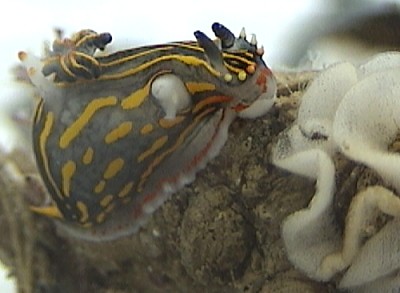
Dear Bill,
I'm from Tunisia, North Africa. I found a number of nudibranchs in a coastal lagoon, in Tunis called "Lac de Tunis". Depth: 0 to 1m. They were found between January - March 2003.
Can you identify them please.
Thanks,
Anis.
Dear Anis,
Welcome to the Forum. Could you please send an email to me at billr@seaslugforum.net. The email address you sent does not work and I can't work out what the error is.
I have split your photos up into separate species which I will post over the next few days. These are the first opisthobranchs on the Forum from Tunisia and contain some quite interesting records. This species is Polycera aurantimarginata. One of the main colour features distinguishing this species is the yellow line just in from the edge of the foot. It is not very clear in your photo, looking more orange or brown. suspect the egg ribbon in your photo belongs to the animal as well. This species has been found from Spain down the coast of Africa to Namibia. I can't find any record of it from within the Mediterranean, so this could be the first Mediterranean record. I am sure one of our colleagues will be able to let us know.
Best wishes,
Bill Rudman
Re: Polycera aurantiomarginata from Senegal
March 28, 2003
From: Juan Lucas Cervera
Dear Bill,
Following Marina's message here are some details about the distribution of Polycera aurantiomarginata:
• In 1989, Ortea & Rolan described Polycera xicoi from Cape Verde Islands, a species similar to P. aurantiomarginata.
• In 2000, Valles et al. recorded and described specimens of P. aurantiomarginata from Angola and Namibia, and considered P. xicoi as a junior synonym of the former.
References:
• Ortea, J. & Rolan, E. (1989) Descripcion de una nueva especie del genero Polycera Cuvier, 1816 (Mollusca, Nudibranchia) del Archipielago de Cabo Verde. Publicaçoes Ocasionais da Sociedade Portuguesa de Malacologia, 14: 23-28.
• Valles, Y., Valdes, A. & Ortea, J. (2000) On the phanerobranch dorids of Angola (Mollusca, Nudibranchia): a crossroads of temperate and tropical species. Zoosystema, 22(1): 15-31.
Regards.
Lucas.
lucas.cervera@uca.es
Cervera, J.L., 2003 (Mar 28) Re: Polycera aurantiomarginata from Senegal. [Message in] Sea Slug Forum. Australian Museum, Sydney. Available from http://www.seaslugforum.net/find/9509Thanks Lucas,
I was not aware of the Valles et al paper. It is very interesting. Of particular interest are their records of the widespread 'tramp' species Polycera hedgpethi, Thecacera pennigera, and Kaloplocamus ramosus from Angola.
Bill Rudman
Polycera aurantiomarginata from Senegal
March 27, 2003
From: Marina Poddubetskaia
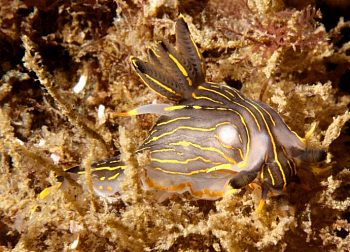
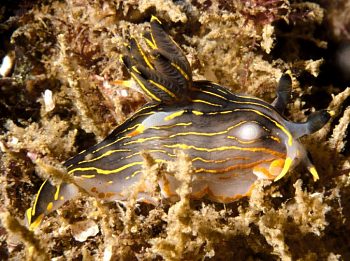
Dear Bill,
Some time ago Patrice Petit de Voize showed me his photos from Dakar, Senegal. Each year he organizes a course on Senegalese fauna there.
I was very glad to discover these photos he had of Polycera. I think this is Polycera aurantiomarginata. So, I really wanted to share this discovery with you, and Patrice said to be happy to contribute to the Forum. He has many photos of this species, so I think it is quite common there. I will send in a separate message photos of mating and spawning. But I didn’t see any obvious feeding behaviour.
So, all the photos were taken by Patrice Petit de Voize [PdeVoize@aol.com] in Dakar on the Tacoma wreck in April 2001. The water was cold, 15-17°C and the depth was from 6 to 12m.
Best wishes,
Marina (and Patrice).
nembro@nembro.info
Poddubetskaia, M., 2003 (Mar 27) Polycera aurantiomarginata from Senegal. [Message in] Sea Slug Forum. Australian Museum, Sydney. Available from http://www.seaslugforum.net/find/9474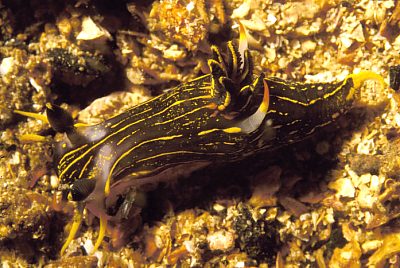
Dear Marian & Patrice,
This is indeed an exciting find, for as far as I know Polycera aurantiomarginata has only been reported from Spanish waters, and then only rarely. The orange-yellow border to the foot, and the blue-black rhinophore club with yellow tip, are both characters unique to this species. There is clearly still a lot for us to learn about the fauna of the west African coast. Any other of Patrice's photos from west Africa are of course very welcome, even of species common elsewhere, as we know so little about the fauna of that region.
Best wishes,
Bill Rudman
Polycera aurantiomarginata - mating & eggs
March 27, 2003
From: Marina Poddubetskaia
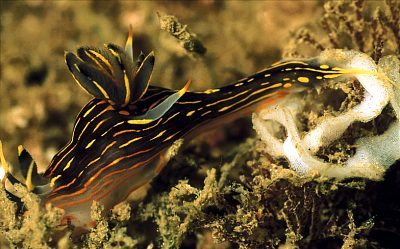
Dear Bill,
As promised in my other message, here are the mating and spawning photos of what I think is Polycera aurantiomarginata. They also were taken by Patrice Petit de Voize [PdeVoize@aol.com] in Dakar, Senegal on the Tacoma wreck in April 2001. The water was cold, 15-17°C and the depth was from 6 to 12m.
Best regards,
Marina (and Patrice).
nembro@nembro.info
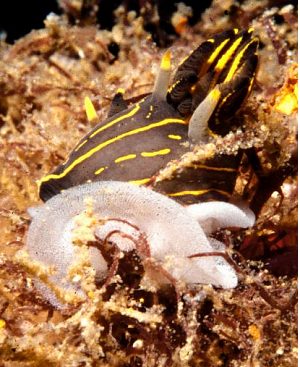
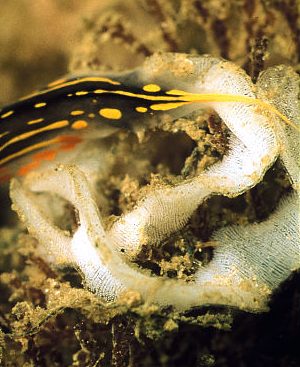
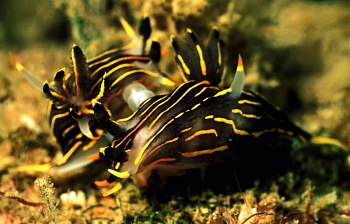
Dear Marina & Patrice,
The orange-yellow border to the foot is very clear in these photos. Thanks again for these very interesting photos. I assume the weed-like growth is the remains of an aborescent bryozoan that these animals have been feeding on. In other species I am familiar with, their food is often quite unrecognisable after they have eaten all the zooids off the stalks.
Best wishes,
Bill Rudman
Polycera aurantiomarginata from Spain
February 22, 2001
From: Alma Sánchez

Dear Dr. Rudman,
Here is a photo for you of Polycera aurantiomarginata García Gómez & Bobo, 1984. This specimen was collected in September, 2000 at the Bay of Algeciras (Strait of Gibraltar, Southern Spain) at 23 depth. Size: 20 mm.
Best wishes,
Alma Sánchez
Dear Alma,
Thanks very much for this interesting species. I have only seen one other photo of it.
Best wishes,
Bill Rudman
